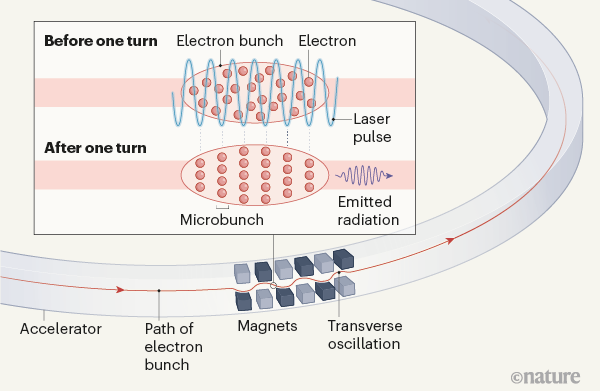For decades, particle accelerators have been used across a wide range of fields, enabling the study of matter in ever-increasing detail. Charged particles emit light when they are accelerated, and accelerators that exploit this phenomenon are among the brightest artificial sources of light available, allowing scientists to probe the properties of matter over unprecedentedly short scales of length and time. Writing in Nature, Deng et al.1 report a proof-of-principle experiment on an accelerator that could extend the capabilities of these machines even further, potentially yielding applications in a next-generation chip-etching technology called extreme-ultraviolet lithography2 and an advanced imaging method known as angle-resolved photoemission spectroscopy3.
The two main types of accelerator-based light source are synchrotrons (circular machines) and free-electron lasers (linear machines). Synchrotrons have a high average power (number of photons produced per unit time) and can generate pulses of light that have tunable wavelengths and a wide bandwidth (range of wavelengths). The high power is possible because ‘bunches’ of particles cycle around the machine many times, producing light at every turn as they travel through a series of magnets of alternating polarity, known as an undulator or a wiggler.
Free-electron lasers have a lower average power than do synchrotrons, because they use a bunch of electrons only once. However, they can generate pulses of light that have a smaller bandwidth and a much higher brightness (up to 10 billion times brighter4) than those produced by synchrotrons. In a free-electron laser, the radiation emitted by the electrons acts back on these particles, causing them to bunch together into regions about the size of the radiation wavelength. The light waves generated by these ‘microbunched’ electrons are coherent (in sync), and reinforce each other to achieve the remarkable brightness mentioned above.
Deng and colleagues’ results are based on a concept called steady-state microbunching5, which aims to bridge the gap between high-power synchrotrons and small-bandwidth, high-brightness free-electron lasers. In steady-state microbunching, an electron bunch in a synchrotron is forced to become microbunched before it emits radiation (Fig. 1). This effect is achieved by firing a (conventional) laser pulse at the electrons while they travel through an undulator. The undulator makes the electrons oscillate transversely, and the laser pulse causes different particles to have different energies.
As this modified bunch travels around the machine, higher-energy electrons are deflected less by the magnetic fields used to steer the particles (and therefore take a longer path) than are lower-energy electrons, making them slip backwards. By the time the electrons have completed a turn through the accelerator, this longitudinal slippage has caused the particles to become microbunched, giving them properties resembling those of the electrons used to drive a free-electron laser. The distance between these microbunches is approximately the wavelength of the incident laser pulse.
As mentioned previously, coherent emission by a microbunched electron beam produces pulses of light that have a much higher power than those generated through incoherent emission. Deng et al. detected the radiation produced by a typical electron bunch at the Metrology Light Source, a synchrotron in Berlin. They then compared this radiation with that of a beam that had been microbunched using their new process.
After using a device called a band-pass filter to remove residual incoherent radiation, Deng and colleagues detected a clear signal from the microbunched beam, indicating that coherent emission was taking place. They corroborated this finding by investigating the dependence of the radiation power on the charge of the electron bunch. The radiation power of a bunch that emits coherently is proportional to the square of the bunch charge, and the authors observed this quadratic dependence by varying the bunch charge and analysing the radiation produced.
Although this paper represents a crucial step towards generating high-power, small-bandwidth light pulses in a particle accelerator, steady-state microbunching has not yet been demonstrated. Deng et al. have shown that, after one turn in the synchrotron, the microbunched beam can produce coherent radiation. The next challenge is to prove that this scheme can achieve such a feat over many turns. This will be difficult to accomplish experimentally for at least three reasons.
First, longitudinal slippage would degrade the microbunching over many turns. Second, for high-power (kilowatt-level) steady-state emission of radiation to occur, incident laser pulses must be synchronized to the arrival of the electron bunch at every turn and confined to an arrangement of mirrors known as a laser cavity. And third, collective interactions between the electrons in the beam, if not controlled using feedback loops, would eventually reduce the power and brightness of the radiation.
A few schemes5–7 that are variants of the original concept could improve the properties of the radiation produced and go beyond Deng and colleagues’ results. Demonstrating such schemes represents a considerable technical challenge, but the authors’ proof-of-principle experiment shows a path towards achieving high-power, high-brightness, small-bandwidth light sources that could outperform current synchrotrons. Moreover, other types of light source, such as storage-ring free-electron lasers8 and energy-recovery linear accelerators9, are under development, and could lead to the next generation of these machines. Although substantial hurdles need to be overcome before such schemes are reliably demonstrated, the authors’ findings provide a glimpse into the future of high-power, accelerator-based light sources.
"light" - Google News
February 24, 2021 at 11:17PM
https://ift.tt/2OXzmuL
Accelerator-based light sources get a boost - Nature.com
"light" - Google News
https://ift.tt/2Wm8QLw
https://ift.tt/2Stbv5k
Bagikan Berita Ini















0 Response to "Accelerator-based light sources get a boost - Nature.com"
Post a Comment